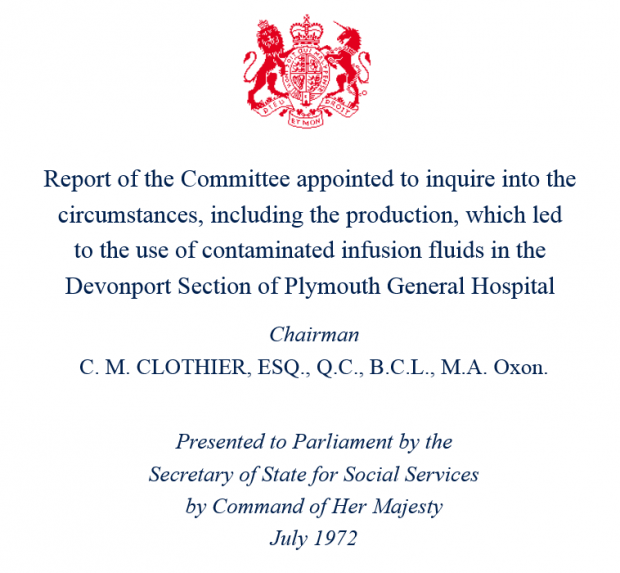
Senior management leadership and commitment of personnel at all levels (in other words, the organisation’s ‘quality culture’) are the foundation of measures that ensure product quality and continuity of supply. Although described in current guidance such as GMP Chapter 1 and ICH Q10, the importance of quality culture has been recognised for nearly half a century.
In 1972, a failure to sterilise a batch of intravenous fluid led to a public health emergency in the UK – often referred to as the ‘Devonport Incident’. The defective medicines were linked to fatalities and the Department of Health initiated what it called a ‘life or death’ search for unused product in the distribution network.
In the days following the incident the Government commissioned C M Clothier to lead an inquiry into the circumstances leading to the use of the contaminated fluids. It was a pivotal investigation in UK medicines history, which continues to influence international GMP requirements 47 years later.

The findings in the Clothier report were wide-ranging, but several are of relevance to quality culture in 2019:
- “There was no imminent technological advance in the field of production of intravenous fluids which will eliminate the need for skillful people devoted to their work”
- there was “a belief that sterilisation of fluids is easily achieved with simple plant operated by people of little skill under a minimum of supervision, a view of the task which is wrong in every respect”
- “Public safety ….. depends ultimately on untiring vigilance both in industry and by government”
The warning was clear: regulations, GMP and inspections alone could not guarantee prevention of similar disasters. Sadly, there have been other examples globally since the 1970s.
Indicators

Despite long-term awareness of its importance, it remains difficult to define and measure ‘quality culture’. MHRA inspectors look for indicators showing that personnel at all levels of the organisation have appropriate technical knowledge to enable good decision-making and understand how their actions impact the product and patient.
A strong quality culture is built upon:
- knowledge of what is important, and how a process achieves critical quality attributes
- diligence, by fostering awareness that everyone contributes to product quality, and understanding that “my actions impact the patient and the company”
- vigilance by individuals who know what ‘right’ and ‘wrong’ look like in their process, and a mechanism for management to be aware of problems
- senior management commitment to being visible and transparent in decision-making so that positive outcomes can be seen from the diligence and vigilance efforts. This is more than the company mission statement – it’s ‘walking the talk’.
Global diversity
Pharmaceuticals utilise an increasingly global manufacturing supply chain. Common approaches to organisational behaviour may not always be effective due to societal considerations and there are many different influences on quality culture. We should be prepared to accept that an effective quality culture in one region may look different to that in another.
By being sensitive to the influence of global culture on organisational behaviour, we gain insight into the effectiveness of the ‘vigilance’ part of the quality culture, which can influence the selection of metrics. What matters is that the desired outcomes are achieved.
Quality culture – facilitating desired behaviours
Enabling a good quality culture requires continued effort from leadership and empowerment at all levels of the organisation. It is facilitated by clear communication of priorities:
- to personnel, helping them to understand the importance of their work
- to shareholders, to avoid unrealistic productivity pressures and explain the business and reputational benefits that a positive quality culture can realise
- to supply chain partners, making clear the information and resource requirements required for a consistent supply of high quality product
Communicating priorities to regulators can also influence the company’s risk profile, and for organisations who consistently demonstrate good quality-focused decision-making, the possibility of achieving regulatory relief as a result.
Back to 1972 ...
In today’s computerised, high-tech pharmaceutical environment, it is worth reflecting on the Clothier report conclusions from 47 years ago.
Technology in 2019 continues to progress at an incredible pace in new product development and novel manufacturing, analytical and supply chain practices. Some of these may require new regulatory approaches, which I will describe in a future blog post.
Despite significant progress in automation, there is still no replacement for a skilled and dedicated workforce who understand the importance of their work. Industry and regulators must maintain the highest levels of quality culture vigilance. I wish you success with these efforts as we go forward in 2019.
Don’t miss the next post, sign up to be notified by email when a new post comes out


9 comments
Comment by John Turner posted on
What your blog does not say is that this incident and the Clothier Report had a significant and reinforcing influence on the work and structure of the then very recently established Medicines Inspectorate (comparable though in smaller scale to the 'Thalidomide' incidents that prompted the Medicines Act 1968 itself). In 1972 GMP inspections had only just started in UK and the 1971 edition of the 'Orange Guide' had a 3-page appendix on sterile products. By 1974 this had been expanded to 7 pages and the Inspectorate from about 8 to 16 inspectors. Certainly regulatory inspections "cannot guarantee prevention of similar disasters", but I'd argue that they have greatly reduced their likelihood.
Comment by RR posted on
Really good blog, thank you.
Would be useful to have a link or area to add these blogs on either/ both blood and gcp forums.
Comment by Willi Ramseier posted on
In German, you don't have a job, you have a Beruf. You are professionally trained and feel appointed to do this work. Of course, this means you are much more expensive than someone from the street with a checklist in hand. Especially in our time of short time memory, nobody thinks in a holistic way anymore. Because, if you would calculate one mistake or poorer quality by a cheaper employee, you would find he's more expensive.
All you (the management) have to do is to appreciate the work people do. Smooth the paths in front of them and keep their backs free. And if they are at the workplace they should be, you will have happy, proud and therefore attentive and highest quality producing employees.
As a quality auditor, I can always see how important the work is for the employees, and what kind of atmosphere toward quality dominates at a workplace. Which, I will address in my audit report and without blame point to the management as the one in charge for the atmosphere.
P.S.: in the 70’s we had ever so much more control and were more accountable for what we did. The bosses (management) trusted and confide in us much more, and expressed a bigger sympathy toward our work.
Willi
Comment by Kevin Dawson posted on
A good article on a very thought provoking subject.
Comment by Francis M Dollard posted on
This article is an excellent reminder of what is really important within our industry-Clothier is as relevant today as he was almost 50 years ago.
People who are motivated, enthusiastic and understanding of their role in the workplace are as important now as ever.
Comment by Dr. Ranjana Pathak posted on
I agree with this write up, I also believe while we may have advanced in many ways by means of technology, the basics remain the same as pointed out (knowledge, diligence, vigilance and senior mgmt involvement).
Thank you.
Comment by Bob Wheeler posted on
David This is a great blog. Really important messages here about culture, quality, safety, empowerment and the role of leadership. It may even underestimate the significance in getting this right and improving financial performance as well as safety. Many thanks.
Comment by Yogesh Davé posted on
Excellent Blog David. Completely agree with your postion.
Quality Culture is so important within a Pharma company for all staff who play a role in making, testing or supplying a medicine.
Despite the numerous advances in the technologies in testing and in the production of sterile products (and also other dosage forms), human interventions still exist and these play a critical role.
Senior management commitment and understanding of quality risk management is the key to drive the right culture in a manufacturing organisation. I believe that this goes beyond having a set of Quality policies and a misson statement but is truly achieved by "walking the talk" and mitigating or eliminating the major risks in their processes and supply chain pratices.
Quality governance is achieved by company leaders and directors establishing the right understanding and ethical standards and encourage the motivation for the staff engaged in GXP activities. Leading by example will give the right desires to build the quality culture.
Comment by raghavendra posted on
Well said David, Quality culture is most desired culture in any pharma company. Every employee should own his role linked to any action not limited to process ,testing, review & approval stages.He should be aware of consquences of not doing right will lead to patient health risk.
So we need a culture of me and my patient culture.